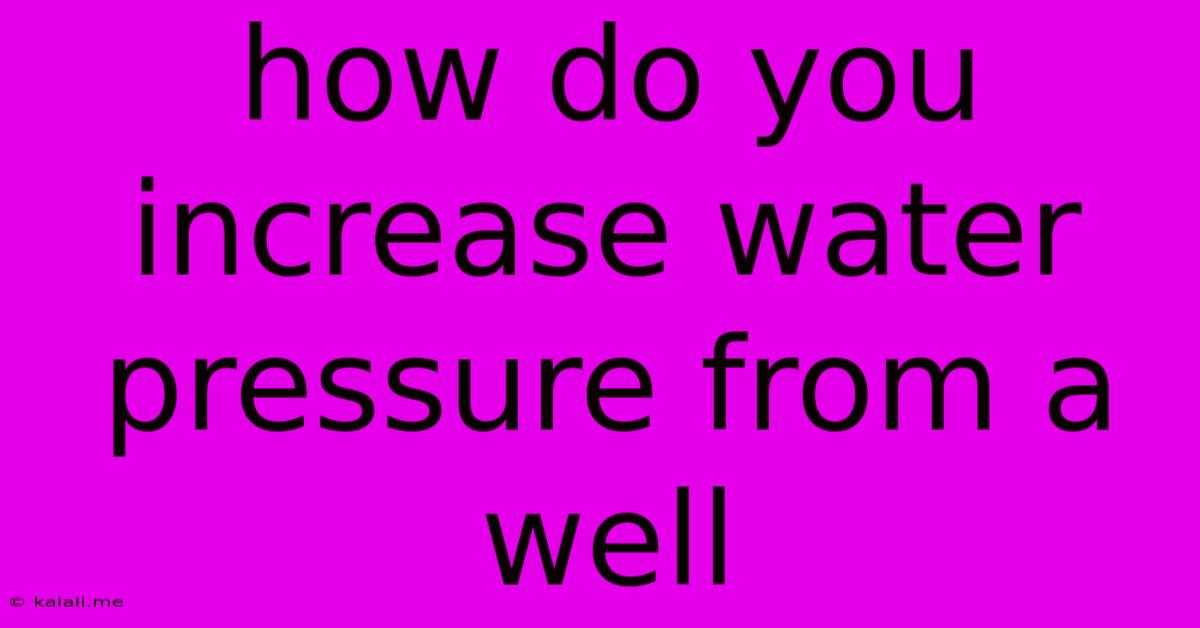How Do You Increase Water Pressure From A Well
Kalali
May 31, 2025 · 4 min read

Table of Contents
How to Increase Water Pressure From a Well: A Comprehensive Guide
Low water pressure from your well can be incredibly frustrating, impacting everything from showering to watering your lawn. This comprehensive guide explores the various reasons behind low well water pressure and offers practical solutions to boost it. Understanding the root cause is crucial for effective troubleshooting and long-term solutions.
Understanding the Causes of Low Well Water Pressure
Before diving into solutions, let's identify the potential culprits behind decreased water pressure:
-
Low Water Levels in the Well: This is a common cause. Factors like drought, excessive water usage, or a poorly-functioning well pump can deplete the water table. A well that's running dry or nearly dry will inevitably deliver low pressure.
-
Clogged or Damaged Pipes: Over time, mineral deposits, sediment, or corrosion can build up inside your well pipes and the plumbing system, restricting water flow and reducing pressure.
-
Faulty Well Pump: A malfunctioning pump, whether it's a submersible or jet pump, is a primary suspect. Worn-out parts, impeller issues, or motor problems can significantly impact water pressure. Regular maintenance and timely repairs are essential.
-
Air in the Lines: Air pockets trapped in the plumbing system can disrupt water flow and lower pressure. This is often noticeable by a sputtering or gurgling sound coming from faucets.
-
Insufficient Pump Size: If your well pump isn't adequately sized for your household's water demands, it might struggle to deliver sufficient pressure, especially during peak usage times.
-
Leaks in the System: Leaks anywhere in the piping system, from underground lines to fixtures inside your home, will reduce overall water pressure. Identifying and repairing these leaks is critical.
-
Pressure Tank Issues: The pressure tank, a crucial component of most well systems, stores water and maintains pressure. If the tank is damaged, leaking, or not properly charged, it can lead to fluctuating or low water pressure. A damaged bladder inside the tank is a common culprit.
Effective Strategies to Increase Water Pressure
Now that we've explored the potential causes, let's discuss practical solutions:
1. Address Low Water Levels:
- Water Conservation: Implement water-saving practices to reduce overall water consumption. This can help replenish the well's water level, particularly during dry periods.
- Well Inspection: Have a professional well contractor inspect your well to assess the water level and the overall condition of the well itself. They can identify if there are issues with the well's construction or if it needs deepening.
2. Repair or Replace Damaged Pipes:
- Professional Plumbing Inspection: A licensed plumber can conduct a thorough inspection to detect and repair any leaks or clogged pipes within your plumbing system. They have the tools and expertise to locate even hidden leaks.
3. Pump Maintenance and Repair:
- Regular Maintenance: Follow the manufacturer's recommendations for regular maintenance of your well pump. This may involve inspecting components, cleaning, and lubricating parts.
- Professional Inspection & Repair: If you suspect your pump is malfunctioning, call a qualified well pump technician. They can diagnose the problem and repair or replace the necessary components.
4. Purge Air from the Lines:
- Opening Faucets: Open all faucets in your home, starting with the ones furthest from the well, to allow air to escape.
- Using a Pressure Relief Valve: Some systems have a pressure relief valve that can be used to manually release air.
5. Consider Pump Upgrades:
- Professional Assessment: A well pump professional can assess your current pump's capacity and determine if a larger or more efficient pump is needed to meet your water demands. This might involve upgrading to a higher horsepower pump or a more efficient model.
6. Locate and Repair Leaks:
- Professional Leak Detection: A plumber can use specialized equipment to detect leaks in your plumbing system, even those that are hidden underground.
7. Pressure Tank Inspection and Repair:
- Professional Service: A well service professional can inspect your pressure tank, check the pressure, and repair or replace it if necessary. This might involve replacing a damaged bladder or recalibrating the pressure switch.
Preventive Maintenance is Key
Regular maintenance is crucial for preventing low water pressure issues. This includes:
- Annual well pump inspections: Preventative maintenance catches issues early before they escalate.
- Regular water testing: Ensures the quality of your well water remains consistent.
- Addressing leaks promptly: Prevents water loss and further pressure reduction.
By addressing the root cause and employing these strategies, you can effectively increase your well water pressure and enjoy a consistently reliable water supply. Remember to always prioritize professional help when dealing with complex well system issues.
Latest Posts
Latest Posts
-
Cooking A Turkey In Convection Oven
Jun 01, 2025
-
Sum Of Series 1 N 2
Jun 01, 2025
-
How Hot Can A 3d Printer Get
Jun 01, 2025
-
Red Black And White Wires Ceiling Light
Jun 01, 2025
-
Why Is Roblox Tagging Everything Other Than Me
Jun 01, 2025
Related Post
Thank you for visiting our website which covers about How Do You Increase Water Pressure From A Well . We hope the information provided has been useful to you. Feel free to contact us if you have any questions or need further assistance. See you next time and don't miss to bookmark.